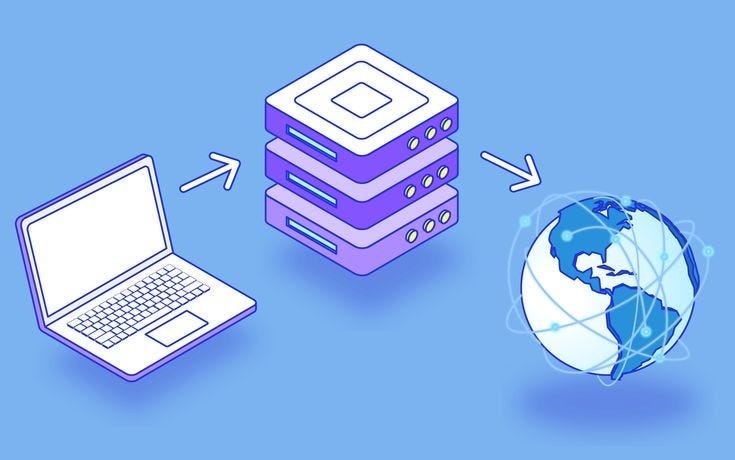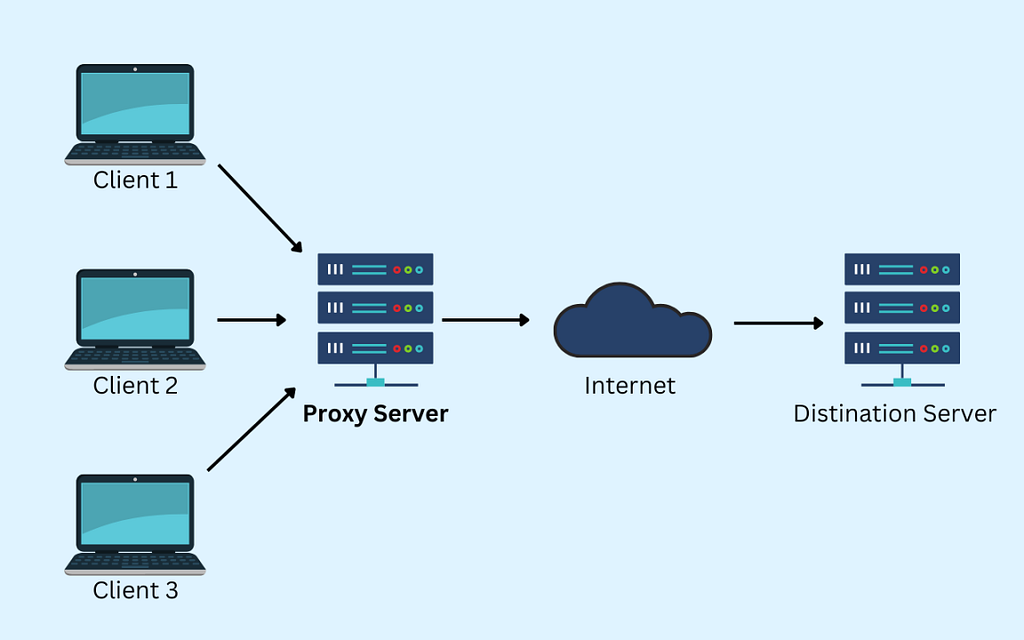This content originally appeared on Level Up Coding - Medium and was authored by Ishaan Gupta
Proxies explained in 5 minutes!

What is a Proxy?
A proxy server refers to a server that acts as an intermediary between client requests and a particular server. The basic purpose of Proxy servers is to protect the direct connection of Internet clients and Internet resources. Didn’t understand?
let me explain it with an example: imagine you’re in a foreign country and don’t speak the local language. Your tour guide (the proxy) takes your requests in English, translates them to the local language for shopkeepers or restaurant staff, and then translates their responses back to English for you. Now you get it, right?
Basically, it acts as a gateway between users and the internet. When you send a request through a proxy, it first goes to the proxy server, which then forwards your request to the intended destination. The response follows the same path in reverse.
Types of Proxy Servers
There are mainly 2 types: Reverse and Forward proxy.
1) Forward Proxy
It simply sits between client devices and the internet. It’s like having a personal ambassador representing you in the outside world. When clients request websites on the internet, it acts as a middleman by intercepting these requests and then talks to web servers on behalf of those clients.

Why is it used?
A forward proxy primarily serves to protect and enhance the client-side experience. Here’s why organizations/institutes implements it:
i) Privacy and Anonymity - When you connect directly to a website, your IP address and location are visible to that site. A forward proxy masks this information by making requests on your behalf. Imagine sending a friend to buy something from a store — the store only knows about your friend (the proxy), not you.
ii) Access Control and Monitoring Organizations - They use forward proxies to enforce internet usage policies. Like a security guard checking IDs at a building entrance, the proxy can:
- Block access to unauthorized websites
- Monitor and log internet usage
- Enforce time-based access restrictions
- Filter malicious content before it reaches users
For large orgs, they usually apply a technique called transparent proxy to streamline the process.
iii) Bandwidth Optimization(by caching) - Forward proxies can significantly reduce bandwidth consumption through caching. When multiple users request the same resource (like a popular article written by ishaangupta1201😅), the proxy saves a local copy after the first request. Subsequent requests are served from this cache — similar to how a library keeps popular books on hand instead of ordering new copies for each reader.
iv) Bypassing Geo-restrictions - Some users use it to access geo-restricted content by routing their requests through servers in allowed regions. Think of it as having a friend in another country buy and ship you products that aren’t available in your region.
I have written a very basic config file for the Nginx forward proxy. If you are a newbie you can skip this part.
worker_processes auto;
events {
worker_connections 1024;
}
http {
# Forward proxy settings
server {
listen 8080;
# DNS resolver settings
resolver 8.8.8.8;
# Access control
location / {
proxy_pass http://$http_host$uri$is_args$args;
proxy_set_header Host $http_host;
# Common proxy headers
proxy_set_header X-Real-IP $remote_addr;
proxy_set_header X-Forwarded-For $proxy_add_x_forwarded_for;
proxy_set_header X-Forwarded-Proto $scheme;
# Basic access restrictions
allow 192.168.1.0/24; # Allow internal network
deny all; # Deny all other access
}
}
}
2) Reverse Proxy
While forward proxies serve clients, reverse proxies serve servers. A reverse proxy is a server that sits in front of web servers and forwards client (e.g. web browser) requests to those web servers. They act as a protective front door to your web applications, directing incoming requests to the appropriate backend servers.

Why it is used?
Reverse proxies focus on protecting and optimizing server-side operations. Here’s why they’re crucial:
i) Load Distribution - Reverse proxies excel at distributing incoming traffic across multiple servers. Like a skilled traffic controller, they ensure no single server becomes overwhelmed by:
- Routing requests to the least busy server
- Automatically removing failed servers from rotation
- Distributing traffic based on geographic location
- Managing sudden traffic spikes
ii) Security Enhancement — A reverse proxy acts as a security shield for your backend servers:
- Hides server infrastructure details from clients
- Manages SSL/TLS encryption centrally
- Protects against DDoS attacks
- Implements rate limiting and request filtering
iii) Performance Optimization — Through various techniques, reverse proxies improve application performance:
- Caching static content close to users
- Compressing responses to reduce bandwidth
- Optimizing SSL/TLS connections
- Implementing HTTP/2 and other modern protocols
iv) Simplified Server Management - Having a reverse proxy allows for:
- Centralized SSL certificate management
- Easy addition or removal of backend servers
- Unified logging and monitoring
- Seamless application updates without downtime
I have written a very basic config file for Nginx reverse proxy. If you are a newbie you can skip this part.
http {
# Defined backend server groups
upstream backend_servers {
# Load balancing algo
least_conn; # Use least conn algo
# Backend servers
server backend1.internal:8080;
server backend2.internal:8080;
server backend3.internal:8080;
# Health check
check interval=3000 rise=2 fall=5 timeout=1000 type=http;
check_http_send "HEAD / HTTP/1.0\r\n\r\n";
check_http_expect_alive http_2xx http_3xx;
}
# Main server configuration
server {
listen 80;
server_name example.com;
# SSL configuration
listen 443 ssl;
ssl_certificate /etc/nginx/ssl/example.com.crt;
ssl_certificate_key /etc/nginx/ssl/example.com.key;
# Security headers
add_header Strict-Transport-Security "max-age=31536000" always;
add_header X-Frame-Options "SAMEORIGIN";
add_header X-Content-Type-Options "nosniff";
# Reverse proxy settings
location / {
proxy_pass http://backend_servers;
proxy_set_header Host $host;
proxy_set_header X-Real-IP $remote_addr;
proxy_set_header X-Forwarded-For $proxy_add_x_forwarded_for;
proxy_set_header X-Forwarded-Proto $scheme;
# Timeouts
proxy_connect_timeout 60s;
proxy_send_timeout 60s;
proxy_read_timeout 60s;
# Buffering settings
proxy_buffering on;
proxy_buffer_size 4k;
proxy_buffers 4 32k;
proxy_busy_buffers_size 64k;
}
# Static content handling
location /static/ {
alias /var/www/static/;
expires 30d;
add_header Cache-Control "public, no-transform";
}
}
}Below is some additional info about transparent proxies that i believe you should know. You can skip if you want :)
What is a Transparent Proxy?

A transparent proxy represents a unique implementation in the proxy server family that intercepts communication between clients and servers without requiring any client-side configuration. Don’t worry, I’ll explain this with a simple example —
Imagine you’re driving on a highway and encounter a toll booth. You didn’t choose to go through the toll booth — it’s simply part of the road infra. Similarly, a transparent proxy intercepts and processes network traffic without the client’s knowledge or explicit configuration.
Transparent Proxies Basic Workflow
- Network traffic is automatically redirected to the proxy server through network-level rules.
- The proxy processes the requests and responses.
- Neither the client nor the destination server needs to know about the proxy’s existence.
Transparent proxies can function as either forward or reverse proxies, depending on their implementation.
1) As a Forward Transparent Proxy:
- Commonly used by ISPs for content filtering
- Implemented in corporate networks for monitoring
- Used for bandwidth optimization without client configuration
2) As a Reverse Transparent Proxy:
- Used in content delivery networks
- Implemented for seamless load balancing
- Applied in traffic management systems
Final Thoughts
In this article, I’ve tried to explain proxies as simply as i can. My goal was to provide you with theoretical knowledge with some practical exmaples. The world of proxy servers is vast and constantly evolving, but I hope this article has given you a solid foundation to build upon.
Your feedback helps me create better content! Please clap if you found this article useful, and share your thoughts in the comments. What topics would you like me to cover next?
Don’t forget to share this article with your network — whether they’re beginners just starting to learn about proxies or experienced devs!
Happy Coding!

Forward Proxy vs Reverse Proxy was originally published in Level Up Coding on Medium, where people are continuing the conversation by highlighting and responding to this story.
This content originally appeared on Level Up Coding - Medium and was authored by Ishaan Gupta
Ishaan Gupta | Sciencx (2025-01-02T18:36:04+00:00) Forward Proxy vs Reverse Proxy. Retrieved from https://www.scien.cx/2025/01/02/forward-proxy-vs-reverse-proxy/
Please log in to upload a file.
There are no updates yet.
Click the Upload button above to add an update.
